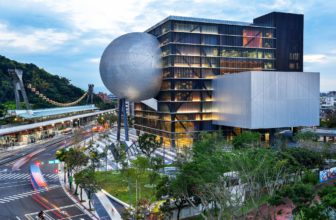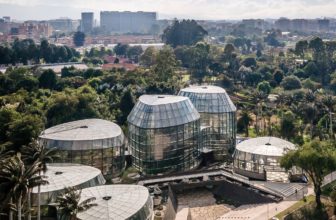Architecture is the scenery of the cinema. Landscapes, houses, and cities consist of frames where filmmakers insert people, lives, and feelings. Their connection is beyond doubt and in some cases the results of this mixture are extraordinary. Architecture interacts with its natural and manmade contexts; the choice of volumes, colors, and textures, and even the circulation in and around architecture dominate the theme of a movie to a great extent. If you are a fan of less drama and more reality, you can check our list of 33 Notable Architecture Documentaries.
10 Architecture Movies Every Architect Should Watch
The following list is a selection of films where architecture plays a key role in the storytelling or forms the background of the stories of the people producing it, the architects.
1. The belly of an architect (1987)
Architect Stourley Kracklite comes from Chicago to the eternal city of Rome to curate an exhibition dedicated to his favorite and visionary architect Etienne-Louis Boullée. Peter Greenaway, who directs the movie, explores the relationship between the city and the monuments, the fertile ideas, and the role of the architect who keeps distinguishing the design from the construction. The exhibition takes place in the monument of Victor Emmanuel III, a pompous mass of white marble, planted in the heart of the historic city. [1]
The director, using his bitter humor, explores the utopian side of architecture, presenting all the unfinished or unrealized projects. The peculiar symbols he uses, with the controversial meaning, transfer us to a dreamy but at the same time nightmare world. The spherical forms dominate the film: fruits, a gyroscope, Newton’s cenotaph, the belly of Kracklite’s pregnant wife, and finally his own belly that grows uncontrolled and lets reality take place where he is absent.
2. Medianeras/Sidewalls (2011)
“Never before people’s roofs were close to one another as they are today. And never before people’s hearts were so far from one another as they are today”. [2] The title is not random as it concentrates wisely on the whole argument of Gustavo Taretto’s work. Sidewalls are literally the blind walls of the huge blocks of megacities and simultaneously they represent the “walls” that stand between people of urban centers, preventing them from communication.
Martin lives alone in an apartment in Buenos Aires, taking care of his dog, making a living out of web design. Marianna lives in the building next door decorating shops with mannequin dolls as she was never able to work as an architect. While they live next to each other they have never met. Starting from these two stories, the director focuses on recording the diseases of modern society: loneliness, sense of isolation, the lack of uniqueness in the crowd. The images are simple and realistic: block of flats in endless lines reminding us of hornet’s nest, plants growing unexpectedly out of concrete and illegal windows built on sidewalls to let the light in.
3. Koyaanisqatsi: Life Out of Balance (1982)
This film has one idea, a simplistic one. It contrasts the glory of nature with the mess made by man. Directed by Godfrey Reggio and with the beautiful soundtrack of Philip Glass, it is an impressive visual and acoustic experience, trying to alert us to the environmental dangers caused by human beings.
Among other landscapes and places of the 1970’s America, we also watch the demolition of the Pruit-Igoe Public Housing project in Saint Louis, Missouri. Designed by modernist architect Minoru Yamasaki, it was considered for a long time a model for urban renewal.[3] However, due to the absence of a political will, the decrease in the industrial economy, and rising racism towards this working-class “ghetto”, Pruit-Igoe fell into disrepair and never recovered. Its demolition signed also the end of modernism.
4. In exchange for five apartments and one shop! (2005)
This docu-essay describes, above all, the architectural and social evolution of Athens as shown in Greek fiction films (from the oldest Greek fiction film of 1924 to those of 2004). It focuses on the general change of the cityscape of Athens due to economic and social transformations. The presence and the narration of four actors who are stigmatized by their interpretation in films of different time periods and cultures are crucial.
The architectural and sociological trek is divided thematically into five sections: The Introduction, The Age of Innocence, The Explosive Adolescence, The Adulthood, and the Epilogue.
5. Dark City (1998)
As in its predecessor Metropolis, Dark City by Alex Proyas presents to us a false world trying to fabricate ideal societies that are doomed to fail when a free spirit person starts questioning the things that surround him. In this city with no light, human memories are fabricated from the beginning, when the clock shows “midnight”. This is an experiment held by the Strangers who have collected a group of people in an artificial society to study them.
All humans lose consciousness. All machinery stops. Changes are made in the city. Skyscrapers are extruded from the primordial materials of the underworld, architecture is devised, rooms are prepared for their inhabitants, props are set in place.[4]
6. The infinite happiness (2015)
The film spotlights the work of Danish architect Bjarke Ingels and his innovative ‘8’ housing development in Copenhagen. Filmmakers Ila Beka and Louise Lemoine instead of interviewing the architect on his projects and work, prefer to follow the life of the residents of this community who share their stories and experiences of living in this new space.
Most of them share funny and happy everyday stories, from birthdays, outdoor activities to Halloween and family gatherings, while there is one of them mentioning his anxiety towards tourists who experience this building as a public space. The fact that sociable housing is a novelty even in Denmark, reveals the large ideological barrier that 8 seeks to overcome.[5]
7. Blade Runner (1982)
In this dystopian science fiction movie, Ridley Scott introduces the viewer to another megacity society falling into decay. Los Angeles in the year 2019 is dark and almost an abandoned city where Replicants – cyborgs engineered by humans for entertaining purposes – try to find shelter to expand their lifespan. Rick Deckard is a “blade runner”, or a hunter of Replicants who lives in Frank Lloyd Wright’s Ennis House.
Unlike the futuristic exteriors of the film scenery, with tall skyscrapers and the rapid evolution of the cars and machinery, the interiors seem dusty and old with conventional, standard furniture, a controversial image, pointing out the decrease of capitalism and habitation of living through architecture.[6]
8. Sanxia Haoren/Still Life (2006)
A town in Fengjie county is gradually being demolished and flooded to make way for the Three Gorges Dam. A man and a woman visit the town to locate their estranged spouses and become witnesses to the societal changes. Fengjie is gradually vanishing underwater, forming a new changing landscape filled with the spiritual drowning of its inhabitants, who see their place disappearing from one moment to another.
Sanming and Shen, the two main characters, are found in a parallel search for their families which they lost years ago, but they never meet with each other. In this transforming and decaying environment, they try to put a closure to their past and move on with their lives.
9. 24 City (2008)
24 City is a 2008 film directed by Chinese filmmaker Jia Zhang Ke. The film follows three generations of characters in Chengdu (in the 1950s, the 1970s, and the present) as the factory they are working in will be demolished to give way to a modern apartment complex. The apartment complex featured in the film is an actual development (also called “24 City”) built on the former site of an airplane engine manufacturing facility.
Balancing between fiction and documentary, Jia Zhang Ke interviews people whose lives are totally dependent on the factory. They share their real-life experiences and the challenges they have to face with the restless sociopolitical changes in 21st century China.
10. The architect (2016)
In this recently released film, Jonathan Parker gathers all the stereotypes that form an architect to his main character Miles Moss, who is hired to design a house for a married couple. He is arrogant, self-centered, and obsessed with his work. Is he building their dream house or his dream masterpiece? Just a light comedy to make us wonder about our profession and how the world sees us.
References
[1] Antonakaki S. (2010), Katoflia, The belly of an architect, Futura, pp. 87-89 [Translated from Greek]
[2] Giannakou D. (2012), Movie review: Medianeras. Retrieved and translated from greek from http://www.clickatlife.gr/cinema/story/10000 [Accessed 29 December 2016]
[3] National Low Income Housing Coalition (2014), 40 Years Ago Pruitt-Igoe Demolished. Retrieved from http://nlihc.org/article/40-years-ago-pruitt-igoe-demolished [Accessed 29 December 2016]
[4] Ebert R. (2005), Dark City Review, Retrieved from http://www.rogerebert.com/reviews/great-movie-dark-city-2005 [Accessed 29 December 2016]
[5] Mullen P. (2016), Review: ‘The Infinite Happiness’. Retrieved from http://povmagazine.com/articles/view/review-the-infinite-happiness [Accessed 29 December 2016]
[6] Kaisar M. (2015), The 10 Best Movies about Architecture, Retrieved from http://www.tasteofcinema.com/2015/the-10-best-movies-about-architecture/ [Accessed 29 December 2016]





